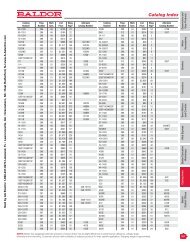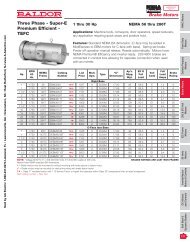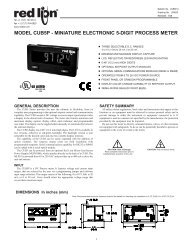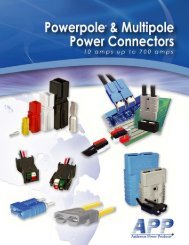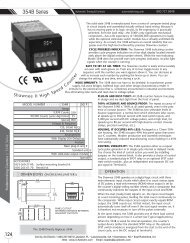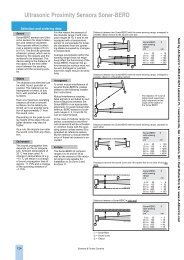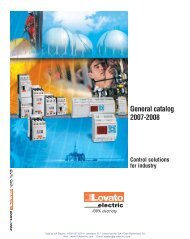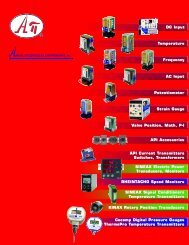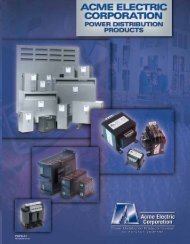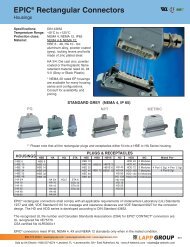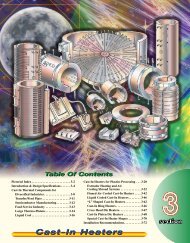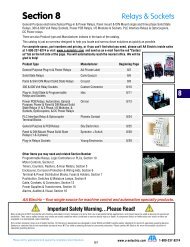G - AA Electric
G - AA Electric
G - AA Electric
You also want an ePaper? Increase the reach of your titles
YUMPU automatically turns print PDFs into web optimized ePapers that Google loves.
Analogue Signal Processing<br />
J<br />
Analogue Signal Processing<br />
Analogue signal processing<br />
Problems<br />
The real environment can be measured in many different<br />
forms, for example in terms of temperature, humidity or air<br />
pressure. The values of these physical variables change constantly.<br />
Elements which monitor the statuses and status<br />
changes of a given environment and supply an indication of<br />
this changed environment must be able to portray the continuous<br />
change.<br />
In industrial monitoring tasks, sensors are responsible for registering<br />
ambient statuses. Sensors provide signals which allow<br />
detailed conclusions for downstream evaluation and monitoring<br />
systems with detailed conclusions about the statuses or<br />
status changes, for example in a production process. Sensor<br />
signals monitor continuous changes in the monitored field.<br />
They occur in digital and analogue form. As a rule, they supply<br />
an electrical voltage or current value which corresponds proportionally<br />
to the physical variables being monitored.<br />
If automation processes are expected to reach certain statuses<br />
or keep them Constant, then analogue signal processing is<br />
required. It is also important in areas where this is has already<br />
been part of long established practice, for example process<br />
engineering or the chemicals industry.<br />
In process engineering, standardised electrical signals are normally<br />
used. Currents from 0… 20 mA, 4… 20 mA or voltages<br />
from 0..10 V have become established as the output variable<br />
for sensors of various different physical parameters.<br />
Weidmüller takes account of the continuing trend to automate<br />
– including and in particular with analogue signal processing –<br />
and offers a wide range of products tailor-made to the requirements<br />
involved in handling sensor signals. Units for the common<br />
signals (0..20 mA, 4..20 mA, 0..10 V) generate an output<br />
signal as proportional values of the variable input signal.<br />
“Protective separation” e.g. of the sensor circuit from the evaluation<br />
circuit is also taken into account. “Protective separation”<br />
prevents mutual interference of several sensor circuits, for<br />
example as in the case of earth ground circuits in linked measuring<br />
circuits.<br />
The wide range of products completely covers the functions<br />
involved in signal conversion, signal separation and signal<br />
monitoring. The products thus satisfy nearly all applications in<br />
industrial measuring technology, and safeguard elementary<br />
functions between field signals and further processing systems.<br />
The mechanical properties of the products are built up<br />
around a continuous concept.<br />
The product programme contains the following functions:<br />
• dc/dc converters<br />
• Current converters<br />
• Voltage converters<br />
• Temperature transformers for resistance thermometers and<br />
thermoelements<br />
• Frequency converters<br />
• Potentiometer transducers<br />
• ac transducers<br />
• Bridge transducers (strain gauges)<br />
• Threshold monitoring modules<br />
• AD/DA converters<br />
The stated products are available as pure signal conversion,<br />
2-way isolation, 3-way isolation and passive disconnectors –<br />
depending on the production functions in each case.<br />
Sold by <strong>AA</strong> <strong>Electric</strong> 1-800-237-8274 Lakeland, FL • Lawrenceville, GA • Greensboro, NC • East Rutherford, NJ www.A-Aelectric.com<br />
Signal converters can be used with other Weidmüller products<br />
and combined with each other. They are designed from an<br />
electrical and mechanical point of view so as to entail a minimum<br />
wiring workload and maintenance.<br />
J.2



